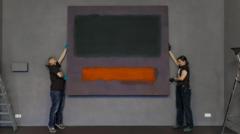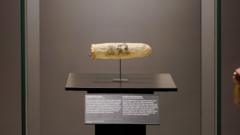A child accidentally caused minor damage to Mark Rothko’s painting Grey, Orange on Maroon, No. 8, valued at €50 million, while on display at the Museum Boijmans Van Beuningen in Rotterdam. The incident has prompted a review of conservation methods and raised questions about museum safety policies for children. Experts emphasize the challenges in restoring modern art due to its sensitive materials.
Child Accidentally Harms €50 Million Rothko Painting at Rotterdam Museum

Child Accidentally Harms €50 Million Rothko Painting at Rotterdam Museum
An unguarded moment leads to minor damage of a valuable Rothko painting, sparking discussions on museum safety protocols and art conservation challenges.
In a remarkable incident at the Museum Boijmans Van Beuningen in Rotterdam, a child inadvertently damaged a highly valued painting by celebrated American artist Mark Rothko. The artwork, Grey, Orange on Maroon, No. 8, is estimated to be worth a staggering €50 million (£42.5 million). Museum representatives indicated the damage occurred during an "unguarded moment," highlighting potential vulnerabilities in museum security protocols.
According to museum officials, the damage to the painting is described as "superficial" with small scratches evident on the lower section of the artwork. They are currently in the process of sourcing conservation expertise both locally and internationally to evaluate the damage and determine the appropriate next steps. Despite the incident, officials remain optimistic about the painting's future display, asserting that it will be showcased again.
Sophie McAloone, conservation manager at the Fine Art Restoration Company, noted that modern unvarnished paintings, like Rothko's work, are particularly vulnerable due to their complex material composition and striking color fields. Scratches can significantly affect the viewing experience, and the experts may face challenges in restoring this unvarnished piece.
Onlookers and art professionals have pointed out the implications this incident may have for other UK institutions, such as V&A East and the British Museum, which are considering unveiling more artworks that had been kept in storage. Jonny Helm, marketing manager at Plowden & Smith, cautioned that the incident may raise questions on how to maintain safety while encouraging public access to artwork.
Interestingly, Rothko's paintings have faced unfortunate circumstances in the past. The 1958 work Black on Maroon was vandalized in 2012 by Wlodzimierz Umaniec at Tate Modern. Umaniec faced legal consequences for the act, and restoration efforts took a lengthy 18 months. This history of damaged Rothko pieces during public viewing contexts expands the conversation on preservation and access.
Rachel Myrtle from Aon indicated that fine art insurance policies commonly cover accidental damage, including incidents involving visitors. When damage occurs, insurers dispatch specialists to assess the situation and conservation alternatives. However, the museum has not disclosed who may bear liability for the Rothko incident, leaving open questions about responsibility.
The Museum Boijmans Van Beuningen has had prior experiences with visitor-related art damage. In 2011, they required a visitor to compensate for repairs after stepping on an artwork. Each museum adopts varying approaches to incidents involving children causing damage; a recent case in Israel saw a vast response towards a young boy accidentally breaking an ancient jar, where the museum opted for leniency and engagement.
As museums engage with broader audiences, particularly children, the balance between accessibility and the safeguarding of valuable artworks remains a vital discussion topic, marked by the recent events in Rotterdam.




















